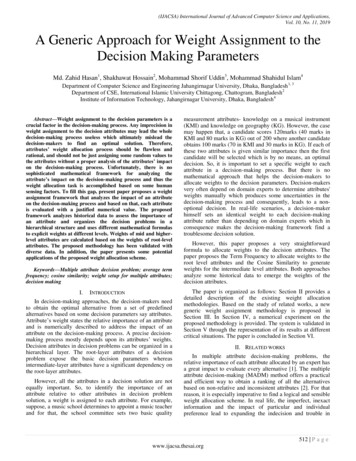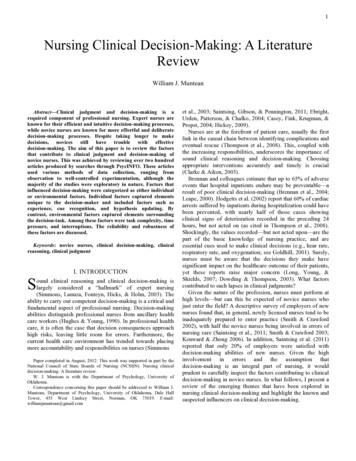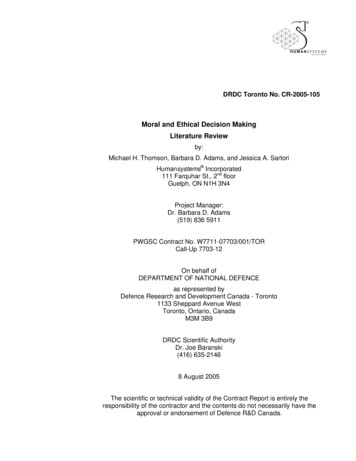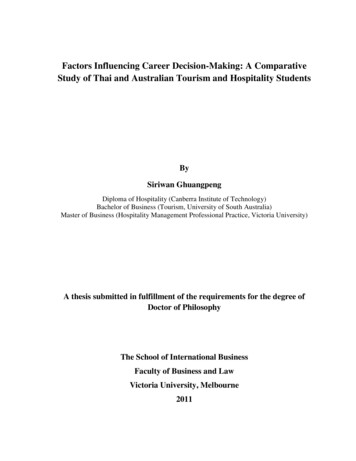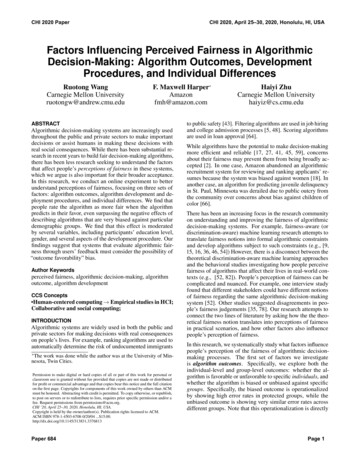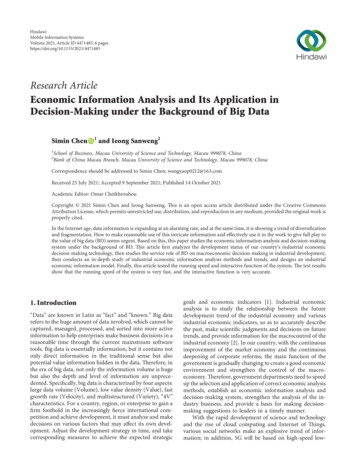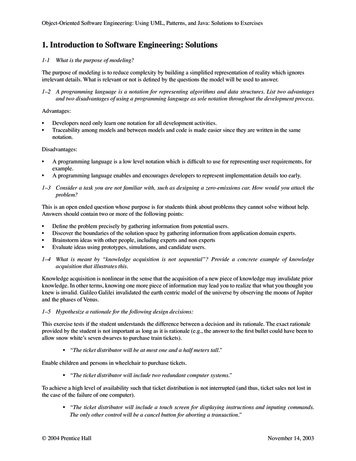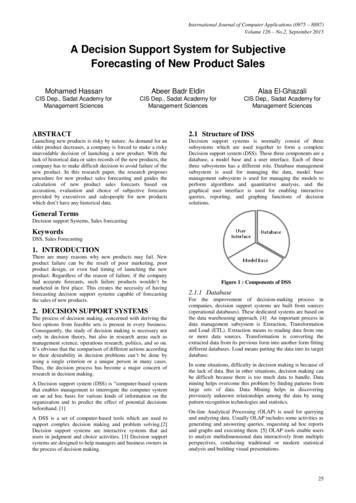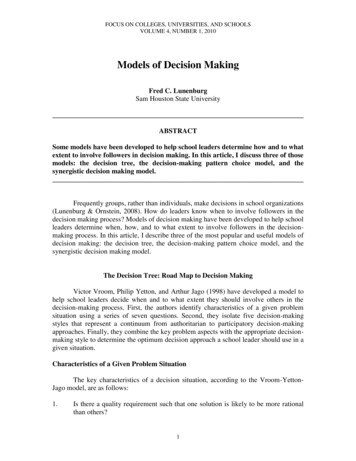
Transcription
FOCUS ON COLLEGES, UNIVERSITIES, AND SCHOOLSVOLUME 4, NUMBER 1, 2010Models of Decision MakingFred C. LunenburgSam Houston State UniversityABSTRACTSome models have been developed to help school leaders determine how and to whatextent to involve followers in decision making. In this article, I discuss three of thosemodels: the decision tree, the decision-making pattern choice model, and thesynergistic decision making model.Frequently groups, rather than individuals, make decisions in school organizations(Lunenburg & Ornstein, 2008). How do leaders know when to involve followers in thedecision making process? Models of decision making have been developed to help schoolleaders determine when, how, and to what extent to involve followers in the decisionmaking process. In this article, I describe three of the most popular and useful models ofdecision making: the decision tree, the decision-making pattern choice model, and thesynergistic decision making model.The Decision Tree: Road Map to Decision MakingVictor Vroom, Philip Yetton, and Arthur Jago (1998) have developed a model tohelp school leaders decide when and to what extent they should involve others in thedecision-making process. First, the authors identify characteristics of a given problemsituation using a series of seven questions. Second, they isolate five decision-makingstyles that represent a continuum from authoritarian to participatory decision-makingapproaches. Finally, they combine the key problem aspects with the appropriate decisionmaking style to determine the optimum decision approach a school leader should use in agiven situation.Characteristics of a Given Problem SituationThe key characteristics of a decision situation, according to the Vroom-YettonJago model, are as follows:1.Is there a quality requirement such that one solution is likely to be more rationalthan others?1
FOCUS ON COLLEGES, UNIVERSITIES, AND SCHOOLS22.3.4.5.6.7.Does a school leader have sufficient information to make a high-quality decision?Is the decision situation structured?Is acceptance of the decision by the school leader's followers critical to effectiveimplementation of the decision?Is it reasonably certain that the decision would be accepted by followers if theschool leader were to make it alone?Do the school leader's followers share the organizational goals to be achieved ifthe problem is solved?Is the preferred solution likely to cause conflict among the followers?In other words, these key variables should determine the extent to which a school leaderinvolves others in the decision process or makes the decision alone, without their input.Decision-Making StylesFive alternative decision-making styles, from which a school leader can choose,include the following:1.2.3.4.5.School leaders solve the problems or make the decision themselves, usinginformation available at that time.School leaders obtain the necessary information from others, then decide on thesolution to the problem themselves. They may or may not tell others what theproblem is when they request information. The role played by others in makingthe decision is clearly one of providing the necessary information to schoolleaders, rather than generating or evaluating alternative solutions.School leaders share the problem with relevant others individually, getting theirideas and suggestions without bringing them together as a group. Then schoolleaders make the decision that may or may not reflect others' influence.School leaders share the problem with other members as a group, collectivelyobtaining their ideas and suggestions. Then they make the decision that may ormay not reflect others' influence.School leaders share a problem with others as a group. School leaders and otherstogether generate and evaluate alternatives and attempt to reach agreement[consensus] on a solution. School leaders do not try to influence the group toadopt their preferred solution, and they accept and implement any solution thathas the support of the entire group (Vroom, Yetton, Yago, 1998).Choosing the Appropriate StyleVroom, Yetton, and Jago match the decision styles to the situation as determinedby answers to the seven questions. By answering these questions, the preferred decisionstyle for each type of problem is identified. Figure 1 depicts how the Vroom-Yetton-Jagomodel works.
FRED C. LUNENBURG31.Is there aqualityrequirementsuch thatone solutionis likely tobe morerational thananother?2.Do youhavesufficientinformation tomake ahighqualitydecision?3.Is theproblemstructured?4.Isacceptanceof decisionsubordinatescritical toimplementation?5.Is itreasonablycertain thatyoursubordinateswouldaccept thedecision ifyou wereto make itbyyourself?NoNoA6.Dosubordinatesshare theorganizational goalsto beobtained insolving oNoDYesDNoCNoYesYesNoYesNoYesYesEAYesFigure 1. The decision tree.7.Is conflictamongsubordinates likelyin thepreferredsolution?NoD
FOCUS ON COLLEGES, UNIVERSITIES, AND SCHOOLS4The flow chart provides the school leader with a step-by-step approach todetermining the most appropriate style of decision making under a given set ofcircumstances. To see how the model works, start at the left-hand side and work towardthe right. When you reach a letter, the letter corresponds to the optimum decision-makingstyle to use.The Vroom-Yetton-Jago model represents an important improvement over rationaldecision-making theory with implications for shared decision making. The authors haveidentified major decision strategies that are commonly used in making decisions, andthey have established criteria for evaluating the success of the various strategies under avariety of situations. Moreover, they have developed an applied model for school leadersto use in selecting decision strategies, which improves the quality of decisions,acceptance of the decisions by others, and minimizes the time consumed in decisionmaking.The Decision Making-Pattern Choice ModelAnother approach to shared decision making, which specifies circumstancesunder which participation should be used, was developed by Robert Tannenbaum andWarren Schmidt (2010). These authors posited seven different decision making patterns,ranging on a continuum from what they call "boss-centered decision making" to"subordinate-centered decision making." (See Figure ershipUse of authorityby the leaderAreas of freedomfor subordinatesLeadermakes rpresentsideas subject tochangeFigure 2. The decision making-pattern choice model.Leaderpresentsproblem,getssuggestions,and makesdecisionLeaderdefineslimits andasksgroup tomakedecisionLeaderpermitssubordinatesto functionwithin limitsdefined bysuperior
FRED C. LUNENBURG5The theme of this approach is that a wide range of factors determine whether ornot directive decision making, shared decision making, or something in between is best.These factors fall into four broad categories: forces in the leader, forces in thesubordinate, forces in the situation, and long-run goals and strategy.Forces in the LeaderSome of the factors operating in the school leader's personality that influence thechoices among the seven decision making patterns from which she must choose includethe following:1.2.3.4.The school leader’s value system. How strongly does the leader feel thatindividuals should have a share in making the decisions that affect them? Or, howconvinced is the leader that the official who is paid or chosen to assumeresponsibility should personally carry the burden of decision making? Also, whatis the relative importance that the leader attaches to organizational efficiency andpersonal growth of staff members?The school leader's confidence in the group members. Leaders differ in theamount of trust they have in other people generally. After considering theknowledge and competence of a group with respect to a problem, a leader may(justifiably or not) have more confidence in his own capabilities than in those ofthe group members.The school leader's own leadership inclinations. Leaders differ in the manner(e.g., telling or team role) in which they seem to function more comfortably andnaturally.The school leader's feelings of security in an uncertain situation. The leaderwho releases control over the decision-making process reduces the predictabilityof the outcome. Leaders who have a greater need than others for predictability andstability are more likely to "tell" or "sell" than to "join."Forces in the Group MembersBefore deciding how to lead a certain group, the school administrator will alsowant to remember that each member, like herself, is influenced by many personalityvariables and expectations. Generally speaking, the leader can permit the group greaterfreedom if the following essential conditions exist:1.2.3.4.5.6.7.Members have relatively high needs for independence.Members have readiness to assume responsibility.Members have a relatively high tolerance for ambiguity.Members are interested in the problem and feel that it is important.Members understand and identify with the goals of the school.Members have the necessary knowledge and experience to deal with the problem.Members expect to share in decision making.
FOCUS ON COLLEGES, UNIVERSITIES, AND SCHOOLS6Forces in the SituationTwo of the critical environmental pressures on the school leader are as follows:1.2.The problem itself. Do the members have the kind of knowledge that is needed?Does the complexity of the problem require special experience or a one-personsolution?The pressure of time. The more the leader feels the need for an immediatedecision, the more difficult it is to involve other people.Long-Run Goals and StrategyAs the school leader works on daily problems, his choice of a decision makingpattern is usually limited. But he may also begin to regard some of the forces mentionedas variables over which he has some control and to consider such long-range goals as thefollowing:1.2.3.4.5.Raising the level of member motivation.Improving the quality of all decisions.Developing teamwork and morale.Furthering the individual development of members.Increasing the readiness to accept change.Generally, a fairly high degree of member-centered behavior is more likely toachieve these long-range purposes. But the successful school administrator can becharacterized neither as a strong leader nor as a permissive one. Rather, she is one who issensitive to the forces that influence her in a given situation and one who can accuratelyassess those that should influence her.The Synergistic Decision Making ModelHow can a school leader effectively put the resources of a group (or a team) towork on a problem? Getting several people together in one location and using each oftheir strengths to facilitate decision making is always a challenge to a leader. Toaccomplish this, the group must work smoothly in a team effort and not be dominated byone individual or factions within the group.The key to creating the proper environment for shared decision making is shownin Figure 3 and is based to a great degree on effective communication skills (Nash, 2011).Following, I examine how each component of the model relates to each of the otherswhen attempting shared decision making.
FRED C. Figure 3. The synergistic decision making model.ListeningActive listening is not an automatic, easy process, especially when feelings aresensitized and frustration is evident within the group. To effectively accomplish the task,however, a listener should do the following: Always respect another's feelingsNever interrupt when another person is talkingNever prejudgeAlways be considerate of someone else's remarkNever let rank or authority influence a commentAlways pay close attention to everything that is saidRespondingAnswering a remark that has been addressed to a group member occasionallyrequires a high degree of skill and tact. An often overlooked fact in shared decisionmaking is that an improper response (even when it is merely perceived that way) canreduce the effects of positive synergism. Accordingly, when responding, an individualshould take care to do the following: Paraphrase the remark, when applicable.Never respond in a disparaging manner.Keep the other person's feelings in mind at all times.Avoid any type of premature judgment.Always assume that the other person has spoken with sincerity.Avoid having the "final say" in the matter.
FOCUS ON COLLEGES, UNIVERSITIES, AND SCHOOLS8ReinforcingThe skill of reinforcing should not be confused with being condescending. Thekey here is to build on the previous remark(s) so as to encourage more creative thinkingfor all individuals on the team. To induce the best type of synergistic effect whenreinforcing, an individual should do the following: Create the proper climate for a non-threatening dialogue.Encourage free discussion by acknowledging appropriate remarks.Accept the other person's right to express themselves freely.Speak in a noncompetitive manner.Build on individual and group ideas.Encourage various viewpoints as they arise.ClarifyingDuring the course of the decision-making process, there will usually be momentswhen a statement or remark made by another person needs clarification. Not to providethat clarification would be a serious mistake. What is important to the process is to getevery possible confusing or unclear point clarified so that some type of judgment can bemade about it. When attempting to clarify, an individual should always take care to dothe following: Phrase the question in a neutral way.Never imply that a foolish question has been raised.Not show any impatience in either voice tone or body language.Deal specifically with the question being addressed.Not generalize about the other person's intentions.Don't assume that you always have the answer.Clearly, there are a variety of problems in decision-making processes. Individualsand groups have various biases and personal goals that may lead to suboptimal decisions.A technique such as the synergistic decision making approach aims to minimize many ofthese problems by allowing individuals greater freedom of expression, and the groupreceives far less filtered information with which to make its decision. Thus, although notperfect, this technique can assist leaders in need of mechanisms to improve both thequality and the timeliness of decisions made by groups in schools.ConclusionModels of decision making have been developed to help school leaders determinewhen, how, and to what extent to involve followers in the decision-making process.Three of the most popular and useful models of decision making (the decision tree,decision-making pattern choice model, and synergistic decision making model) werediscussed.
FRED C. LUNENBURG9The Vroom-Yetton-Jago decision tree model of determining the level of groupinvolvement in the decision-making process requires the leader to diagnose a problemsituation and the effect participation will have on the quality of the decision, level of staffmembers acceptance, and the time available to make the decision.Another approach to shared decision making, which specifies circumstancesunder which participation should be used, is Tannenbaum and Schmidt’s decisionmaking-pattern choice model. The model posits seven different decision making patternsranging on a continuum from “boss-centered decision making” to “subordinate-centereddecision making.” Nash’s synergistic decision making model is a technique for increasingthe advantages and limiting the disadvantages of shared decision making.ReferencesLunenburg, F. C., & Ornstein, A. O. (2008). Educational administration: Concepts andpractices (5th ed.). Belmont, CA: Wadsworth/Cengage.Nash, M.(2011). Developing language and communication skills through small groupwork. New York, NY: Taylor & Francis.Tannenbaum, R., & Schmidt, W. (2010). How to choose a leadership pattern. Boston,MA: Harvard Business School Press.Vroom, V., Yetton, P., & Jago, A. (1998). The new leadership: Managing participationin organizations. Englewood Cliffs, NJ: Prentice Hall.
synergistic decision making model. The Decision Tree: Road Map to Decision Making Victor Vroom, Philip Yetton, and Arthur Jago (1998) have developed a model to help school leaders decide when and to what extent they should involve others in the decision-making process. First, the authors identify characteristics of a given problem
